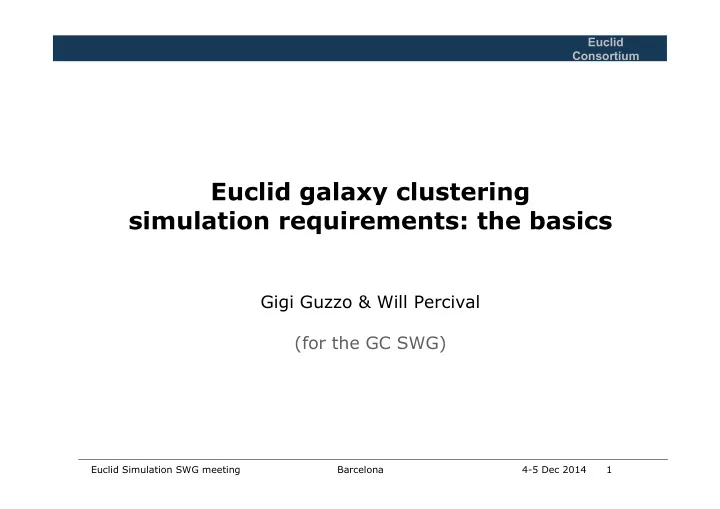

Euclid Consortium Euclid galaxy clustering simulation requirements: the basics Gigi Guzzo & Will Percival (for the GC SWG) Euclid Simulation SWG meeting Barcelona 4-5 Dec 2014 1
Why redshift surveys need simulations… Euclid Consortium 1. Understand and fully characterize survey selection function(s) (ideal vs observed Universe): Verify that experiment will deliver as planned • Quantify and cure instrumental systematic effects • Quantify and minimize modeling systematic effects • Need very realistic mock catalogues in terms of size, � clustering and galaxy properties (mass resolution, photometric and spectral properties, …) 2. Estimate statistical errors Build representative and reliable covariance matrices • Need possibly less detailed mock catalogues, but in very � large number (e.g. PT-halos, Pinocchio, COLA…) Euclid Simulation SWG meeting Barcelona 4-5 Dec 2014 2
Typical survey idiosyncrasies… holes, gaps Euclid Consortium Fisher matrix prediction 1.04 single contiguous 7% lost area 1.035 10 arcmin 2 holes 5 arcmin 2 holes 1.03 � ( � ) / � ( � ) full 1.025 1.02 1.015 1.01 1.005 1 0.93 0.94 0.95 0.96 0.97 0.98 0.99 1 v/v full D. Bianchi & LG, Red Book Euclid Simulation SWG meeting Barcelona 4-5 Dec 2014 4
…but ¡there ¡is ¡more ¡to ¡Euclid… ¡ Euclid Consortium A slitless experiment… Will it work at all? Euclid Simulation SWG meeting Barcelona 4-5 Dec 2014 5
Euclid 1deg 2 of (simulated) Euclid spectroscopy Consortium Euclid Simulation SWG meeting Barcelona 4-5 Dec 2014 6
Euclid NISP performance e2e simulations (Garilli et al.) Consortium Step 1: catalog, observing Step 2: for each object (K<22.5), Step 3: simulate dispersed strategy, instrument parameters simulate image and incident objects (TIPS) in all spectrum (+ stars) dithers Declination Right Ascension Step 5: Measure redshift and reliability (OU- SPE), compute completeness and purity Step 6: Apply Completeness and Purity to Step 4: extract spectra and combine all expected counts, produce dN/dz dithers (AXE -> OU-SIR) Euclid Simulation SWG meeting Barcelona 4-5 Dec 2014 7
The key ingredient: the input catalogue… Euclid Consortium Need to reproduce accurately (to z=2!): a. Large-scale structure (for realistic projection/confusion) b. Galaxy spectral properties (for realistic population abundance and distribution) c. LSS and galaxy properties need to be correlated as in real Universe, as this is crucial for performance test 1. Use n-body+semi-analytic mock (e.g. Durham) Precise redshifts, area ~10-100 deg 2 , as deep as we like • LSS description ~OK (we know P(k), halos vs galaxies?) • Galaxy population and connection to LSS not fully realistic • (at the time): how many Ha emitters? Where do they form? 2. Use a real, observed multi-band catalogue COSMOS field: 30 photometric bands from radio to X-ray • Accurate photo-z to z=2 • Very good knowledge of galaxy SEDs � robust identification • of flux-limited Ha population + correct location within LSS Very small field (<2 deg2) • Euclid Simulation SWG meeting Barcelona 4-5 Dec 2014 8
Simulations need to reproduce this accurately … Euclid Consortium Colours: (U-B) rest frame Cucciati & VIPERS team, in prep. Euclid Simulation SWG meeting Barcelona 4-5 Dec 2014 9
How is the input catalogue built in detail Euclid Consortium (Roche and Zamorani 2011 � see document on RedMine • Starting point: COSMOS IRAC Catalogue (Ilbert 2010), 1.4x1.4 deg • Accurate photo-z known, very extended SED known • Derive galaxy type and stellar mass from SED fitting , direct association with spectral template from Bruzual & Charlot (no emission lines) • Spectral type � SFR � Ha luminosity : add H lines to spectrum • Derive metallicity from stellar mass and SFR � build line ratios accordingly (Dopita 2006 models) � add metal lines to spectrum • Derive reddening from E B-V Euclid Simulation SWG meeting Barcelona 4-5 Dec 2014 10
Euclid e.g. GC Interim Science Review simulations… Consortium Ngal= 3141 (F>3e-16) Ngal= 3667 (F>2e-16) UPDATED Interim Science review fig. 8.2 *4-red 0.9 start *3-red 0.9 start ● red+blue baseline Euclid Simulation SWG meeting Barcelona 4-5 Dec 2014 11
Where do we go from here… Euclid Consortium Combine advantages of both approaches (work ongoing, as seen earlier today): 1. Need larger area mocks Push down cosmic variance • 2. Improved semi-analytic methods? How close to reality can they be? • Especially in correctly placing star-forming objects within the • surrounding structure And following the evolution of this through time? • 3. A hybrid approach? E.g. “dress” a large, good resolution n-body sim with • galaxies built with the right SED and SFR-density relations, taken from a real catalogue like COSMOS, in probabilistic sense (in particular, correct type-density relation as a function of redshift…) Enough information? • Euclid Simulation SWG meeting Barcelona 4-5 Dec 2014 12
2. Errors / Likelihood / Covariance Euclid Consortium • e.g. Alina’s talk this morning… • Needed as to optimize all stages of data analysis • Including approach to likelihood calculation and error determination • For this we need to test with many realizations of “Euclid universes” • We cannot rely on N-body simulations for ~10,000 mock surveys • Approximate methods - fast N-body, Lagrangian PT-based (e.g. PTHalos, Pinocchio, COLA, …) • Need to balance accuracy and speed • As with all mocks, the sooner we have these, the better • These are not just required on the same time-scale as the data, but are required now ! • Existing expertise and activity (WP in OU-LE3, Monaco et al.): time scales? Euclid Simulation SWG meeting Barcelona 4-5 Dec 2014 13
Recommend
More recommend